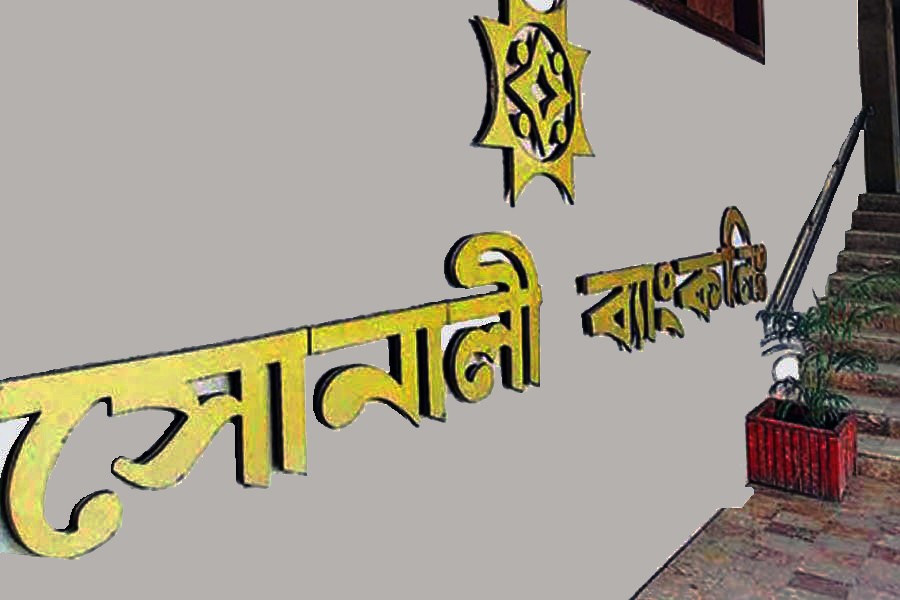Sonali Bank's classified credits bloated to Tk 137.98 billion in 2017 with its recovery drive dropping to 8.0 per cent as the defaulters allegedly duped the bankers.
Sources in the biggest bank of Bangladesh said its loan-recovery rate had been on a fast decline, year on year, at least over the last five years since 2013 as the bad borrowers took recourse to various ploys.
The repayment rates have fluctuated sharply between 50 per cent and 8.0 per cent in the five years to the last calendar year, according to official statistics prepared by the state-owned commercial bank -- Sonali Bank Limited -- which also witnessed a big loan forgery.
People at the bank told the FE in the past week that the recovery rate had been dwindling getting caught in long litigation processes as well as dilatory moves by the debtors.
They said the default clients submit notices to the courts seeking to go for "mutual arbitration" but, in the end, they backtrack and deprive the bank of getting its money back.
On the other hand, contradicting the bank's view, some experts in the financial sector told the FE that there are some loans which have never been realised partly on political considerations, partly for negligence and partly poor 'due diligences'.
They think there is need for a strong political commitment to give the commercial bank a strong footing in matters of its operations.
Sonali Bank, the country's biggest bank in terms of paid-up capital, had a recovery of over Tk 51.76 billion against the total classified credits worth Tk 103.77 billion in 2013. The recovery was approximately 50 per cent.
Amid the ups and downs in the drive the recovery slightly rose to 52 per cent in 2014, when the bank recovered Tk 45.06 billion against the classified loan amounting to Tk 86.43 billion.
An ebb tide thereafter brought the rate deep down in 2015 by 21 percentage points to Tk 27.26 billion against Tk 86.85 billion worth of classified loans.
In the subsequent year (2016) its recovery rate just stood at 12 per cent with the bank netting back Tk 12.88 billion against Tk 109.11 billion.
In a turn for the worst so far, its recovery rate in 2017 plummeted just to 8.0 per cent or Tk 10.91 billion against its classified-loan hangover of Tk 137.98 billion.

The Sonali Bank had a total loan until 2017 amounting to Tk 422.76 billion -- more than 5.0 per cent of the aggregate loans in the country.
Of the outstanding loans, Sonali has got over Tk 214.87 billion trapped in cases pending with both lower and high courts since the inception of 'Artha Rin Adalat' sometime in 2003.
In the banking-system parlance, there are four types of classified loans: special-mention account if clients fail to repay within 90 days. In this case, banks' accrued interest on the loans will not be shown as profit.
If the clients fail to repay instalments within 180 days, the loans are treated as substandard, and in this case banks have to maintain provisioning at the rate of 20 per cent from their earnings.
If clients fail to repay within 270 days, the loans become doubtful and banks maintain 50 per cent provisioning.
Lastly, if clients fail to make repayment within 360 days, the loans emerge as bad and loss where cent-per cent provisioning is required.
Banks usually lodge cases with the Artha Rin Adalat in the last resort at the 'bad & loss' stage.
After filing cases, banks in many cases write off the loans to show their accounts clean but claim their money back through litigation.
Khondaker Ibrahim Khaled, a former deputy governor of the central bank of Bangladesh, elaborated on the whole spectrum of bank lending and the tricks of the trade in the sector. There are some big loans "never been realized", he told the FE.
And there are some loans marked with lack of proper due diligence, some negligence from the officials concerned. "So I believe that some big loans will never be recovered," he said.
The noted banker recommended the formation of an enquiry committee to assess the real causes behind the failures in loan recovery.
Dr Mirza Azizul Islam, another financial-market expert, thinks the loans with "political connections" would never be realised.
He also said there are some big cases where immovable assets given as mortgage and other sorts of property remained so low that the banks would never get the amount it lent out.
There are many default loans outside the courts and why the bank has failed to realise that portion is a moot question, he said.
"In my view there are some negligence and corruption…," Dr Islam added.
In the meantime, the state-owned commercial bank, which also failed to provide any dividend to the national exchequer following its negative retained earnings, is now pursuing a new strategy to raise the volume of recovery.
The measures are: strengthening arbitration with default parties, raising personal contact with the defaulters and, finally, filing cases against the clients.
The bank officials told the FE that they had a total "cash recovery" of nearly Tk 8.0 billion in 2017. It also shows "others" in recovery that includes, among others, recovery from the rescheduling of loans.
The Sonali Bank turned nationalised commercial bank in 1972, under the Bangladesh Banks (Nationalisation) Order, through the amalgamation and nationalisation of the branches of the National Bank of Pakistan, the Bank of Bahawalpur and the Premier Bank branches located in the then East Pakistan.
At the inception, after Bangladesh's independence from Pakistan, the Sonali Bank had a paid-up capital of 30-million taka. Its paid-up capital now stood at Tk 38.30 billion with the number of employees and branches counting 18,806 and 1,212 respectively.


